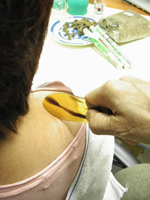Scraping Therapy for Cancer Patients
 |
| TCM holds that scraping with horn tools facilitates the elimination of evils from the body surface, while scraping with jade or stone tools can have tonifying effect. |
Scraping therapy (Gua Sha) is an old and popular folk therapy. By using blunt, smooth, round-edged tools and lubricated with vegetable oil or warm water, the operator scrapes on the patient's neck, shoulder or back. Manipulate repeatedly from top to bottom, from inward to outward, until the skin area turns purplish red color. Some of the commonly used tools are horn sticks, tender bamboo films, Chinese tablespoons and coins.
From a TCM viewpoint, this therapy promotes qi (vital energy) and blood circulation, draws perspiration so as to relieve syndromes of the exterior, benefits the tendons, activates the meridians and also regulates the organs. In the end, various pathogens can be expelled through the body's surface.
This techniques is so easily to use that the general public also like to use this technique for relieving symptoms associated with sunstroke, flu, motion sickness and food distention. Clinically, because of its ease of use and popularity, physicians usually employ it in along with other therapies for conditions such as common cold, fever, sunstroke, headache, gastric intestinal problems, neck stiffness, shoulder pain, lumbago, muscular contractions, and rheumatic arthritis.
When employing scraping therapy in cancer treatment, patients can benefit from its general enhancement, circulation promoting and painkilling effects. Selection of areas of stimulation is similar to acupoints in acupuncture and should be in accordance with the diagnosis of specific conditions.
In early and middle stages of cancer, scraping therapy can work with other routine treatments to help inhibit inflammatory reactions, activate blood flow, provide pain relief and calm down the spirit. Acupoints commonly used are: yu-ji, nei-ting, zhao-hai, zu-san-li, gong-sun, xing-jian, ge-shu, wei-shu, gan-shu, pi-shu, da-chang-shu, tian-shu and cheng-shan.
For cancer patients who are recovering from conventional treatments, this method helps promote body functioning, replenishes the blood and qi, and increases resistance. Commonly applied acupoints are: feng-chi, shen-zhu, du-shu, guan-yuan, qi-hai, gan-shu, pi-shu, wei-shu, zu-san-li, shang-ju-xu, ming-men, shen-shu, yang-guan and yang-ling-quan.
In cases of vomiting, commonly used acupoints are tian-tu, zhong-wan, nei-guan, da-dun, san-yin-jiao and tai-yuan.
For feverish conditions, use feng-chi, feng-fu and da-zhui.
Each time pick 3-4 areas; then gently scrape in the same direction until the skin area appears red and purple marks appear.
This technique is not suitable for thin individuals with skin lesions, a tendency to bleed easily or those with severe conditions. Never scrape the tumor site directly.
|